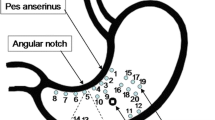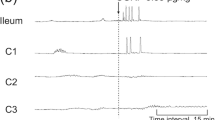Abstract
The effect of electrical dysrhythmias on the mechanical activity of the fed stomach was investigated in 5 conscious dogs implanted with Ag-AgCl electrodes and strain gauge force transducers. Each dog was fed 1 can of ALPO® and electromechanical activities of the stomach were recorded for the next 120 min. The results show that intraarterial boluses of met-enkephalin (75 μg/kg), PGE2 (36 μg/kg), and epinephrine (36 μg/kg) induced episodes of antral dysrhythmias whereas saline (1 cc) did not. The postcibal antrat motility index for the test period was not altered following saline injection, but it was reduced by 61%, 70%, and 81% following the administration of met-enkephalin, epinephrine, and PGE2, respectively (p<0.01 vs. baseline period). During periods of normal electrical rhythm, PGE2 and epinephrine significantly reduced the antral motility index (2.07±0.93 and 3.24±0.79, respectively) vs. saline (7.92±0.44) (p<0.05 for both drugs) whereas met-enkephalin (4.98±0.56) did not. In contrast, during episodes of dysrhythmia, met-enkephalin significantly depressed antral motility (1.70±0.74) (p<0.05 vs. periods with normal electrical rhythm) whereas neither epinephrine nor PGE2 caused a further reduction in antral motility from what was seen during periods of normal electrical rhythm (1.84±0.72 and 1.34±0.37, respectively). We thus conclude that intraarterial administration of met-enkephalin, PGE2, or epinephrine induce gastric dysrhythmias postcibally and depress antral contractile activity. The relaxatory effect of met-enkephalin on antral contractions is primarily due to its dysrhythmic effect whereas PGE2 and epinephrine inhibit antral motility even when the electrical rhythm is undisturbed.
Similar content being viewed by others
References
Szurszewski JH: Electrical basis for gastrointestinal motility.In Physiology of the Gastrointestinal Tract. LR Johnson (ed). New York, Raven Press, 1981, pp. 1435–1466
Morgan KG, Szurszewski JH: Mechanisms of phasic and tonic action of pentagastrin in canine gastric smooth muscle. J Physiol 301:229–242, 1980
Szurszewski JH: Mechanism of action of pentagastrin and acetylcholine on the longitudinal muscle of the canine antrum. J Physiol (London) 252:335–361, 1975
Hinder RA, Kelly KA: Human gastric pacesetter potential. Am J Surg 133:29–33, 1977
Abell TL, Camilleri M, Malagelada J-R: High prevalence of gastric electrical dysrhythmias in diabetic gastroparesis. Gastroenterology 88:1299, 1985 (abstract)
Code CF, Marlett JA: Canine tachygastria. Mayo Clin Proc 49:325–332, 1974
Gullikson GW, Okuda H, Shimizu M, Bass P: Electrical arrhythmias in gastric antrum of the dog. Am J Physiol 239:G59-G68, 1980
Hamilton JW, Bellahsene BE, Reichelderfer M, Webster JG, Bass P: Human electrogastrograms: Comparison of surface and mucosal recordings. Dig Dis Sci 31:33–39, 1986
Kim CH, Azpiroz F, Malagelada J-R: Characteristics of spontaneous and drug-induced gastric dysrhythmias in a chronic canine model. Gastroenterology 90:421–427, 1986
Stoddard CJ, Smallwood RH, Duthie HL: Electrical arrhythmias in the human stomach. Gut 22:705–712, 1981
Telander RL, Morgan KG, Kreulen DL, Schmalz PF, Kelly KA, Szurszewski JH: Human gastric atony with tachygastria and gastric retention. Gastroenterology 75:497–501, 1978
Vantrappen G, Schippers E, Janssens J, Vandeweerd M: What is the mechanical coorelate of gastric dysrhythmia? Gastroenterology 86:1288, 1984 (abstract)
You CH, Chey WY: Study of electromechanical activity of the stomach in humans and in dogs with particular attention to tachygastria. Gastroenterology 86:1460–1468, 1984
You CH, Lee KY, Chey WY, Menguy R: Electrogastrographic study of patients with unexplained nausea, bloating and vomiting. Gastroenterology 79:311–314, 1980
Abell T, Tucker R, Malagelada J-R: Glucagon-evoked gastric dysrhythmias in healthy humans demonstrated by an improved electrogastrographic method. Gastroenterology 88:1932–1940, 1985
Sanders K, Menguy R, Chey W, You C, Lee K, Morgan K, Kreulen D, Schmalz P, Muir T, Szurszewski J: One explanation for human antral tachygastria. Gastroenterology 76:1234, 1979 (abstract)
Camilleri M, Malagelada J-R, Brown ML, Becker G, Zinsmeister AR: Relationship between antral motility and gastric emptying of solids and liquids in humans. Am J Physiol 294:G580-G585, 1985
El-Sharkawy TY, Morgan KG, Szurszewski JH: Intracellular electrical activity of canine and human gastric smooth muscle. J Physiol 279:291–307, 1978
Daniel EE: The electrical and contractile activity of the pyloric region in dogs and the effects of drugs. Gastroenterology 49:403–418, 1965
Sanders KM, Bauer AJ, Publicover NG: Regulation of gastric slow wave frequency by prostaglandins.In Gastrointestinal Motility. C Roman (ed). Lancaster, England, MTP Press, 1984, pp 77–85
Reinke DA, Rosenbaum AH, Bennett DR: Patterns of dog gastrointestinal contractile activity monitoredin vivo with extraluminal force transducers. Am J Dig Dis 12:113–141, 1967
Roborgh JR: Motility cycles in the stomach of the fasting dog. Acta Physiol Pharmacol Neerl 14:12–17, 1966
Sarna SK, Bowes KL, Daniel EE: Gastric pacemakers. Gastroenterology 70:225–231, 1976
Mroz C, Kelly KA: The role of the extrinsic antral nerves in the regulation of gastric emptying. Surg Gynecol Obstet 145:369–377, 1977
Kelly KA, Code CF, Elveback LR: Patterns of canine gastric electrical activity. Am J Physiol 217:461–470, 1969
Author information
Authors and Affiliations
Additional information
This work was supported in part by the USPHS, NIH grants AM26428, AM07198, and AM34988 and the Mayo Foundation.
Rights and permissions
About this article
Cite this article
Kim, C.H., Zinsmeister, A.R. & Malagelada, JR. Effect of gastric dysrhythmias on postcibal motor activity of the stomach. Digest Dis Sci 33, 193–199 (1988). https://doi.org/10.1007/BF01535733
Received:
Revised:
Accepted:
Issue Date:
DOI: https://doi.org/10.1007/BF01535733




